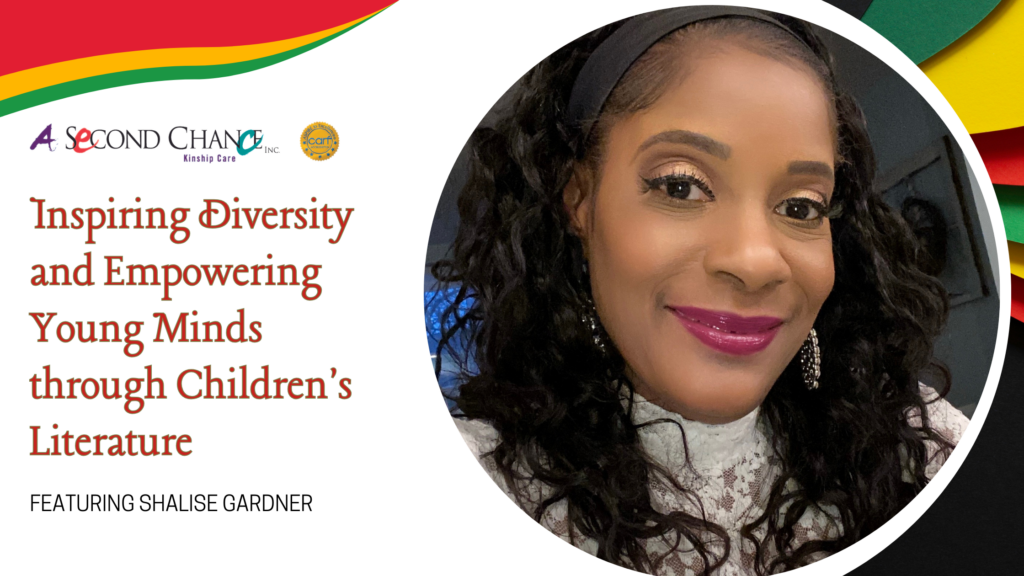Blog
Inspiring Diversity and Empowering Young Minds through Children’s Literature
Every month, A Second Chance, Inc. highlights the voices of our kinship families. As an organization dedicated to creating a secure and nurturing environment for children in the care of relatives or close family friends, commonly referred to as kinship care, we understand the significance of exploring the real-life experiences of caregivers, birth parents, and children. Our goal is to extract invaluable insights that contribute to genuine narratives and shape meaningful programs. Through these conversations, we aim to promote understanding and establish a supportive community for kinship families. This month, we were privileged to engage in a discussion with Shalise Gardner, a children’s book author and CARES Worker II at ASCI, focusing on the crucial topic of the representation of Black youth in literature.

In the vibrant world of children’s literature, Shalise Gardner’s inspiration for crafting tales brimming with diversity and imagination stems from a deeply personal source – her grandson, Malik. With a fervent desire for him to have access to high-quality reading material featuring characters who reflect his own image, Shalise embarked on a journey to create stories that inspire not only Malik but children everywhere to embrace the magic of their imagination.
As an African American, Shalise recognizes the significance of representation in the development of her characters and the narratives of Adventures of Sable Brown. The family scenes she illustrates – from shared dinners to bedtime routines – serve as touchpoints for African American children to identify with and see themselves in the stories. It’s a celebration of culture, family, and the universal experiences that bind us together.
Shalise’s storytelling is a tapestry woven with cultural elements, a reflection of her own upbringing and experiences. From family dinners reminiscent of her own childhood, to positive learning experiences, her books aim to instill values that transcend cultural boundaries. It’s about inspiring young minds to incorporate positivity into their daily lives, fostering habits like family dinners and bedtime routines that leave a lasting impact on their mindset.
“My books are positive learning books and I want the reader to incorporate all positive aspects into their own daily living. This is very important and very impactful because it will change the mindset of the reader” Shalise tells ASCI.

Adventures of Sable Brown – Outer Space extends its embrace to children of all cultures, providing a cosmic journey to learn about the moon, stars, and sun. For Shalise, it’s paramount that Black children understand their imagination knows no bounds, reaching far beyond the familiar realms of home and school.
Representation, according to Shalise, is a powerful force in empowering young readers. When children see characters who resemble them, it sparks curiosity, inspiration, and a sense of hope. It’s a validation of their identity, making them feel good inside and instilling a belief that they, too, can embark on exciting adventures within the pages of a book.
Shalise’s lessons extend beyond the pages of her books. She encourages readers to embrace exploration, learn new things, and recognize the world’s vast opportunities for creating their own adventures through familial bonds.
She urges readers, “Don’t be afraid to explore and learn new things. There is a whole world with opportunities for you to take and make your own adventure. Value your family and start some daily habits to make them into traditions.”
For aspiring artists, Shalise’s advice is rooted in self-love and cultural pride. To pursue creativity, one must first embrace and celebrate their identity, feeling grounded and proud of who they are. It’s a powerful foundation upon which artistic pursuits can flourish.
As an African American woman, Shalise explores themes of identity, race, and cultural heritage in her work. The name “Sable Brown” itself carries profound meaning, representing the dark brown or black color she identifies with. It’s a reflection of her, an acknowledgment and celebration of Shalise’s own identity.
Shalise’s dedication to the importance of supportive networks echoes loudly. Caregivers, mentors, and educators play a vital role in nurturing the artistic aspirations of youth in care. Activities such as art classes, community involvement, and mentorship programs are instrumental in helping young artists explore and develop their creative potential.
“Caregivers, mentors, and educators can get the youth involved in activities that will help develop their art such as art classes at school and in the community. Libraries have local artists and authors to showcase their talent. Youth can go to these places and see themselves represented in ways they may not have imagined.”
She told ASCI.
The arts community, Shalise suggests, can actively contribute to fostering mentorship opportunities by initiating conversations, creating plans, and providing the necessary tools, supplies, and space for young talents to flourish. It’s a collaborative effort that can pave the way for a new generation of artists.
Finally, Shalise offers advice to emerging Black artists navigating the arts industry. It’s a call to work hard, be patient, stay focused, and surround oneself with a supportive team. Remaining open to change, staying humble, and being selective about sharing personal journeys are crucial aspects. Networking and seeking guidance through prayer become guiding lights on the path to artistic success.
In essence, Shalise’s journey is a demonstration to the transformative power of storytelling, the importance of representation, and the profound impact art can have on shaping young minds. Her words resonate as a call to embrace diversity, celebrate cultural identity, and create a nurturing environment for emerging artists to thrive.